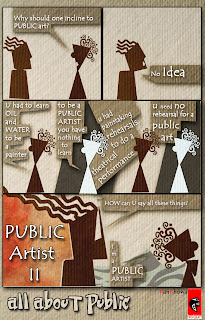1
As I proposed, I want to build a house, reside/dwell inside it and then make a procession with it and finally want to burn it down. Now there is a ritual in Assam, that follows almost similar activities. It is called Magh Bihu or Bhogali Bihu, a winter harvesting festival, when the folks make out a house (known as Bhelaghar), stay one night, have a grand feast and in the very next morning they burn it down.
Initially when I conceived this idea of disposable house, I didn't keep in mind about the bhelaghar – with what lot of my childhood memories are attached. It only in the time of conversation with the jury I suddenly remembered Bhelaghar.
Dwijen Mahanta, a theatre practitioner and photographer collected some photographs for us in Biswanath Chariali.
 |
The Making of Bhelaghar, photographs were taken on 12 Jan 2011, from Bhir Gaon and Bamgaon, Biswanath Chariali, Assam, by Dwijen Mahanta |
Now what I propose is a project of Art, and what they do is a ritual or tradition. Here grows a distinction between US and THEM, ART and RITUAL and to extend the line a distinction between Art and Public.
Here I would not extend the discussion in this blog. I leave it open for discussion, and may be some other day we would open up the same discussion again. Here let us look at the documented photographs and have an idea about the Bhelaghar.
2
Other than Dwijen Mahanta, I talked to Kavita Saharia who already put a blog on bhelaghar and extensively also on the Magh bihu. Here I present some nice visuals from her collection with her permission.
see:
Kavita writes: “On the eve of Sankranti(URUKA) a special temporary makeshift cottage or a small house like structure called Bhelaghar is made .This structure is mainly built by the men folk using Bamboo,hay,wood -pieces .After preparing and enjoying a feast inside the bhelaghar,men spend the night there and in the early hours of the next morning lit the bhelaghar down. Its ashes are then spread to the fields and the trees to bring luck for a better harvesting in future.”
“Usually it is a small hut like structure but for the last two years youths of MISAKHOLAHAAT a village 5-6 kms away from our village have started a trend of making it in a grand way." Here are some amazing visuals from a particular Bhelaghare making:



3
Now here is a poem from Siddhartha Sankar Kalita on Bhelaghar:
bhelaghar Siddhartha Sankar Kalita
On the eve of Magh Sankranti
We used to make the Bhelaghar.
We made a structure of beams with unripe bamboo
and putting the hay into it,
when the harvesting is over,
we challenged each other on our skills in making a house.
...and the grand feast was in the evening.
A little prayer was on our palms in the next morning.
and then
fire!
A grand fire event were happening,
The house was burnt down in no time,
The craft of our immature hands were disposed
When we were grown ups
many colorful thoughts
started building a house in ourselves.
And yeah! Juvenile was there to put fire to it.
We were burnt, we were hurt,
still the flamboyant thoughts started building
a house inside.
A thought could generate another one in itself.
Hence, even after the destructions
we thought of the house a permanent one, a concrete one.
It was another story of
Bhelaghar only
made with our unripe hands...





































